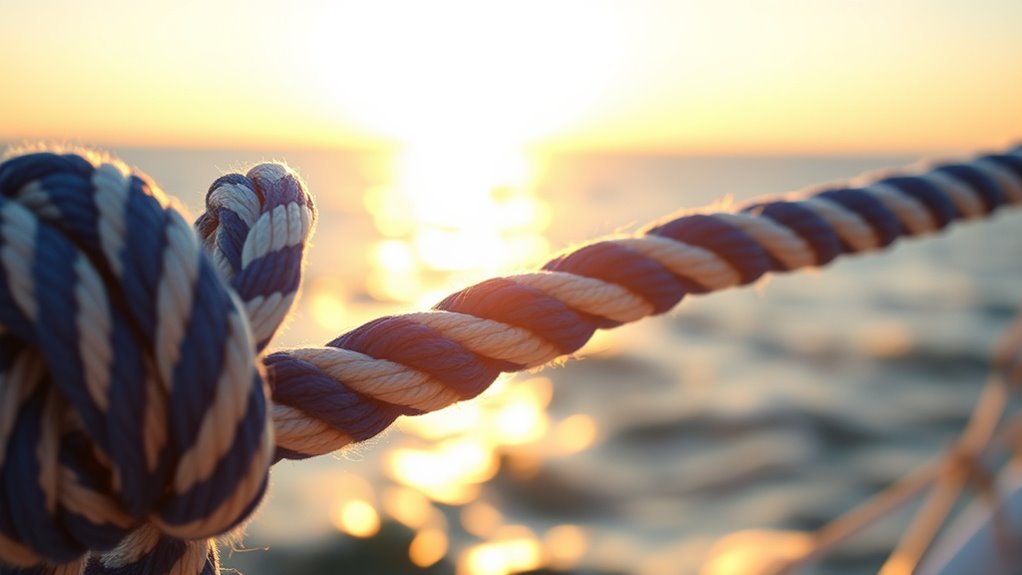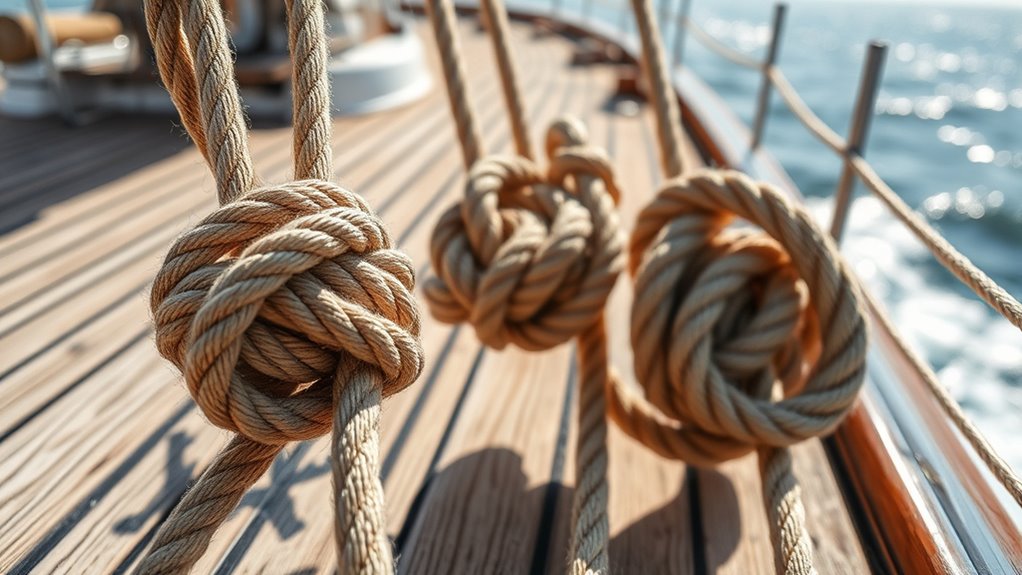As a skipper, mastering essential sailing knots enhances your safety and efficiency on the water. Start with the bowline for securing sails, the clove hitch for fastening lines to posts, and the figure-eight as a reliable stopper knot. Don’t forget the sheet bend for joining lines of different diameters. These knots not only boost your confidence but are critical for quick adjustments in emergencies. Discover more knots that can elevate your sailing skills even further.
Key Takeaways
- Master the Bowline knot for securing sails and creating fixed loops, essential for heavy loads and quick adjustments.
- Use the Clove Hitch to efficiently secure fenders or lines to posts, ensuring versatility in various docking situations.
- Employ the Figure-Eight knot as a reliable stopper knot to prevent slipping through blocks, vital for sail management.
- Utilize the Sheet Bend to join lines of different diameters, providing strength for sail adjustments and effective line management.
- Familiarize yourself with these knots to enhance safety, performance, and confidence while sailing.

When you’re out on the water, knowing the right sailing knots can make all the difference. The strength of your knots can determine how well your sails perform, how secure your lines are, and ultimately, how safe your sailing experience will be. Mastering a few essential knots not only enhances your confidence but also guarantees you’re prepared for any situation. So, let’s delve into some of the best tying techniques every skipper should know.
Knowing the right sailing knots enhances performance, security, and safety, ensuring you’re ready for any situation on the water.
First up is the bowline knot. This classic knot creates a fixed loop at the end of a line, which is perfect for securing sails or mooring your boat. It’s renowned for its knot strength and reliability, even under heavy loads. To tie a bowline, make a small loop in the standing part of the line. Then, feed the working end through this loop, wrap it around the standing part, and pull it back through the loop. This knot’s simplicity makes it easy to untie even after bearing weight, which is a vital factor when you’re in a hurry.
Next, consider the clove hitch. This versatile knot is excellent for securing fenders or lines to a post. To tie a clove hitch, wrap the line around the post twice, crossing over itself with each turn. Tuck the working end behind the standing part and pull tight. It’s quick and efficient, but keep in mind that its knot strength can decrease if the line shifts under load.
The figure-eight knot is another essential. It’s often used as a stopper knot, preventing lines from slipping through blocks. To tie it, create a loop in the line, then wrap the working end around the standing part and pull it through the loop. This knot is not only easy to remember but also incredibly strong, making it a favorite among sailors.
Lastly, let’s touch on the sheet bend. This knot’s strength shines when you need to join two lines of different diameters. To tie a sheet bend, form a loop with the thicker line, then pass the thinner line behind it and through the loop. Wrap it around the thicker line and pull it back through the loop. This knot holds firmly, even under tension, and is invaluable for adjusting sails.
Frequently Asked Questions
What Materials Are Best for Practicing Sailing Knots?
For practicing sailing knots, you’ll want to use synthetic ropes and natural fibers. Synthetic ropes, like nylon or polypropylene, offer durability and resistance to weather, making them great for learning. Natural fibers, such as hemp or cotton, provide a traditional feel and can help you understand how knots behave under tension. Experimenting with both types will enhance your knot-tying skills, giving you versatility when you’re out on the water.
Can I Use These Knots for Other Outdoor Activities?
Absolutely, you can use those knots for other outdoor activities! These multifunctional knots are perfect for camping, whether you’re securing a tarp, setting up a hammock, or tying down gear. They offer reliability and strength, making them adaptable for various situations. Just practice a bit to guarantee you get the hang of them. You’ll find that mastering these knots enhances your outdoor experiences and keeps everything secure while you enjoy nature!
How Do I Know Which Knot to Use in Different Situations?
To know which knot to use in different situations, you should consider the required knot strength and tying techniques. For securing items, a square knot works well, while a bowline is great for creating a loop. If you need to join lines, a sheet bend is effective. Always assess the load and purpose before choosing. Practicing various knots will help you become more confident in selecting the right one for any task.
Are There Any Online Resources for Learning Sailing Knots?
Absolutely, you can set sail on a sea of knowledge with online resources! Picture steering through video tutorials that show you every twist and turn of knot tying. You’ll feel like a master sailor in no time. Plus, interactive apps can be your trusty compass, guiding you through different knots with ease. So grab your device, and let these resources help you tie up your skills and confidence on the water!
How Can I Remember the Names of Different Knots?
To remember knot names, use mnemonic devices and visual aids. Create a phrase or story that links the knot’s purpose to its name, making it easier to recall. For instance, think of a “bowline” as a “bow line” for tying boats. Draw diagrams or use images to visualize each knot’s structure. Repetition also helps, so practice tying the knots while saying their names aloud. With these techniques, you’ll remember them effortlessly!
Conclusion
Mastering these sailing knots isn’t just a nice-to-have; it’s essential for every skipper. Whether you’re tying down gear or securing a sail, knowing the right knot can make all the difference when you’re out on the water. So, don’t wait until you’re caught between a rock and a hard place—practice these knots until they become second nature. With a little time and effort, you’ll be ready to tackle any sailing challenge that comes your way!










